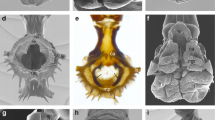Abstract
Results of a karyological analysis of eight species collected from northeast Anatolia, Turkey are presented. The following chromosome numbers were determined:H. medianiforme (Litv. etZahn)Juxip 2n=36,H. karagollense (Zahn)P.D. Sell etC. West 2n=36,H. argillaceoides (Litv. etZahn)Juxip 2n=36,H. amblylepis Boiss. 2n=27,H. lanceolatum Vill. 2n=27,H. asterodermum (Woronow etZahn)Juxip 2n=27,H. umbellatum L. 2n=18,H. laevigatum Willd. 2n=27. The chromosome numbers of five of these seven species are presented for the first time. The results show a high proportion of triploids and tetraploids within the taxa studied.
Similar content being viewed by others
References
Asker S.E. &Jerling L. (1992):Apomixis in plants. CRC Press, Boca Raton, etc.
Bergman B. (1935): Zytologische Studien über sexuelles und asexuellesHieracium umbellatum.Hereditas 20: 47–64.
Bergman B. (1941): Studies on the embryo sac mother cell and its development inHieracium subg.Archieracium. Svensk Bot. Tidskr. 35: 1–42.
Christoff M. (1942): Die genetische grundlage der apomiktischen fortpflanzung beiHieracium aurantiacum L.Z. Indukt. Abstammungs- Vererbungsl. 80: 103–125.
Christoff M. &Popoff A. (1933): Zytologische Studien über die GattungHieracium.Planta 20: 440–447.
Chrtek J. (1994): Chromosome numbers in selectedHieracium species in the Krkonoše Mts. (the West Sudeten).Folia Geobot. Phytotax. 29: 91–100.
Chrtek J. (1996): Chromosome numbers in selected species ofHieracium (Compositae) in the Sudeten Mts. and the Western and Ukranian Eastern Carpathians.Fragm. Florist. Geobot. 41: 783–790.
Chrtek J., Mráz P. &Severa M. (2004): Chromosome numbers in selected species ofHieracium s.str. (Hieracium subgen.Hieracium) in the Western Carpathians.Preslia 76: 119–139.
Chrtek J. jun.,Szeląg Z., Mráz P. &Severa M. (2002):Hieracium silesiacumKrause [H. sparsum subsp.silesiacum (Krause)Zahn] v Západních Karpatech (Hieracium silesiacumKrause [H. sparsum subsp.silesiacum (Krause)Zahn] in the Western Carpathians).Bull. Slov. Bot. Spoločn. 24: 81–90.
Coşkunçelebi K. &Beyazoglu O. (2002): New combinations and records forHieracium L. &PilosellaHill (Asteraceae) in Turkey.Edinburgh J. Bot. 59 (2): 319–324.
Fedorov A.A. (1969):Khromosomnye chisla tsvetkovykh rastenii (Chromosome numbers of flowering plants). Nauka, Leningrad.
Gadella T.W.J. &Kliphuis E. (1967): Chromosome numbers of flowering plants in the Netherlands III.Proc. Kon. Ned. Akad. Wetensch. C. 69: 541–556.
Goldblatt P. & Johnson D.E. (1991): Index to plant chromosome numbers 1988–1989.Monogr. Syst. Bot. Missouri Bot. Gard. 30.
Goldblatt P. & Johnson D.E. (1994): Index to plant chromosome numbers 1990–1991.Monogr. Syst. Bot. Missouri Bot. Gard. 51.
Gottschlich G., Coşkunçelebi K. &Beyazoglu O. (2000): Four new species ofHieracium L. (Compositae) from NE Turkey.Willdenowia 30: 279–291.
Gustaffson A. (1946–1947): Apomixis in higher plants I–III.Acta Univ. Lund. N.S. 42: 1–67; 43: 69–179; 43: 181–371.
Hayirlioğlu-Ayaz S. &İnceer H. (2001): Chromosome numbers of someAlchemilla L. (Rosaceae) species.Acta Biol. Cracov., Ser. Bot. 43: 45–49.
Yuxip A.Y. [Üksip A.Y.] (1960): Yastrebinka —Hieracium L. In:Shishkin B.K. &Bobrov E.G. (eds.),Flora SSSR (Flora USSR) 30, Izdatel’stvo Akademii nauk SSSR, Moskva, Leningrad, pp. 1–732.
Lövkvist B. &Hultgård U-M. 1999. Chromosome numbers in South Swedish vascular plants.Opera Bot. 137: 1–42.
Májovský et al. (1970): Index of chromosome numbers of Slovakian flora (Part 1).Acta Fac. Rerum Nat. Univ. Comenianae, Bot. 23: 1–26.
Májovský et al. (1974): Index of chromosome numbers of Slovakian flora (Part 3).Acta Fac. Rerum Nat. Univ. Comenianae, Bot. 23: 1–20.
Merxmüller H. (1975): DiploideHieracien.Anales Inst. Bot. Cavanilles 32: 189–196.
Měsíček J. &Javůrková-Jarolímová V. (1992):List of chromosome numbers of the Czech vascular plants. Academia, Praha.
Mráz P. (2003): Mentor effects in the genusHieracium s. str. (Compositae, Lactuceae).Folia Geobot. 38: 345–350.
Mráz P. & Szeląg Z. (2004): Chromosome numbers in selected species of the genusHieracium andPilosella (Asteraceae) from Romania.Ann. Bot. Fenn. 41 (in press).
Rechinger K.H. &Lack H.W. (1977):Hieracium L. In:Rechinger K.H. (ed.),Flora Iranica 122, Akademische Druck- und Verlagsanstalt, Graz, pp. 171–180.
Rosenberg O. (1917): Die Reduktionsteilung und ihre Degeneration inHieracium.Svensk. Bot. Tidskr. 11: 145–206.
Rosenberg O. (1927): Die semiheterotypische Teilung und ihre Bedeutung für die Entstehung verdoppelter Chromosomenzahhlen.Hereditas 8: 305–338.
Schuhwerk F. (1996): Published chromosome counts inHieracium. http://www.botanik.biologie.uni-muenchen.de/botsamml/projects/chrzlit.html
Schuhwerk F. &Lippert W. (1999): Chromosomenzahlen vonHieracium (Compositae, Lactuceae) Teil 2.Sendtnera 5: 269–286.
Schuhwerk F. &Lippert W. (1999): Chromosomenzahlen vonHieracium (Compositae, Lactuceae) Teil 3.Sendtnera 6: 197–214.
Sell P.D. &West C. (1975):Hieracium L. In:Davis P.H. (ed.):Flora of Turkey and the East Aegean Islands 5, Edinburgh University Press, Edinburgh, pp. 696–746.
Sell P.D. &West C. (1976):Hieracium L. In:Tutin T.G. et al. (eds.),Flora Europaea 4, Cambridge University Press, Cambridge, pp. 358–410.
Selvi F. &Fiorini G. (1996): Karyology ofHieracium L. subg.Hieracium (Asteraceae) from mount Amiata (Central Italy).Caryologia 49: 287–299.
Uhríková A. &Feráková V. (1977): [Report]. In:Löve Á. (ed.), IOPB chromosome number reports. LVI,Taxon 26: 263.
Vladimirov V. &Szeląg Z. (2001): Reports (1271–1277). In:Kamari G., Blanche C. & Garbari F. (eds.), Mediterranean chromosome number reports — 11,Fl. Medit. 11: 435–483.
Vladimirov V. (2000): Diploid species of the genusHieracium s.l. in Bulgaria.Abh. Ber. Naturkundemus, Görlitz 72, Suppl.: 16.
Zahn K.H. (1921–1923):Compositae-Hieracium. In:Engler A. (ed.),Das Pflanzenreich IV/280, Wilhelm Engelmann, Leipzig.
Author information
Authors and Affiliations
Corresponding author
Rights and permissions
About this article
Cite this article
Hayirlioğlu-Ayaz, S., İnceer, H. Chromosome numbers of some species of the genusHieracium s.str. (Asteraceae) from Turkey. Folia Geobot 39, 319–325 (2004). https://doi.org/10.1007/BF02804784
Received:
Revised:
Accepted:
Issue Date:
DOI: https://doi.org/10.1007/BF02804784




